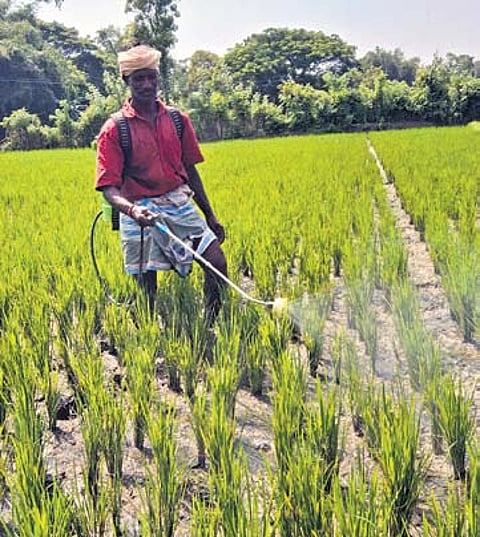

NEW DELHI : When the Union government recently gave its green light for the production and use of nano urea plus for three years, agriculture scientists and experts feared it could hamper agricultural productivity and threaten the country’s food security. The worry was about nano urea’s efficiency as the government’s claims were based on inadequate field trials. Reports from farmers and scientists who had tried it out suggested it had lowered crop production instead of enhancing it.
The government’s nano urea push is aimed at substantially reducing the import of chemical fertilizers while improving soil quality. India imports over 20% of its annual requirement of 35 million metric tonnes of urea and more than half of DAP (diammonium phosphate).
The subsidy bill for these chemical fertilizers sold to farmers is a whopping `1.8 trillion per year. Last year, a parliamentary panel recommended the use of nano urea to save up to Rs 250 billion on annual subsidies. The government provides Rs 20,000 as subsidy on one tonne of urea.
The problem with nano urea is this: a 45 kg bag of subsidised neem-coated urea granules contains 46% nitrogen. And nano urea in liquid form in a 500 ml bottle is being marketed as an equivalent to the 45 kg bag. But the half litre bottle contains just 4% nitrogen.
Nano urea plus, which is to be exclusively manufactured by IFFCO (Indian Farmers Fertiliser Cooperative Ltd), would have 16% nitrogen. IFFCO’s nano urea was launched in June 2021 to reduce the conventional urea usage by 50% while maintaining similar grain yields. “IFFCO’s nano urea plus is an advanced nano urea formulation where nutrition is redefined to meet crop nitrogen requirement at the critical crop growth phase,” said Dr U S Awasthi, CEO of IFFCO.
Earlier, on April 26, 2023, Union Home Minister and Minister of Cooperation, Amit Shah, launched IFFCO’s nano DAP (Liquid). He appealed to farmers to use liquid nano urea and DAP instead of granular urea and DAP.
Ground reports
Contrary to the IFFCO’s claims, scientists and farmers are yet to get confidence in nano urea. There are instances in Punjab, Haryana, Madhya Pradesh, Tamil Nadu and other states where farmers tried nano urea but found it inefficient and costly.
For example, Haryana-based farmer Satpal Choudhary, 64, used nano urea in 2022 on his wheat crop. “I sprayed nano urea on the fields but realised after three weeks that it had no impact, so I went back to using conventional urea,” he informed.
Another farmer, Praveen Parmar, 40, based in Madhya Pradesh’s Shehore district nixed nano urea after it didn’t deliver as promised. “I planted wheat on eight acres and used five litres of nano urea for half of the crops. In the rest of the land, I used conventional urea. I soon realised the ineffectiveness of nano urea and went back to the conventional one,” said Parmar. Similar experiences have been reported from Tamil Nadu, too.
A study by a group of scientists at the Punjab Agriculture University (PAU) for two years on the use of nano urea, found a 13% decrease in rice yield and 21.6% drop in wheat production. “Besides productivity, nutrition content in the grain had also substantially reduced, posing a potential threat to the needs of the large malnourished population in the country,” said Dr Rajiv Sikka, a soil scientist at PAU, who led the study. “It significantly reduces protein content and yield while increasing the cost of production,” he added.
There were many reports that local dealers were forcing farmers to buy nano urea along with a bag of conventional urea in Punjab, Haryana and other states in 2022-23. After protests by farmer organisations, the Union ministry of chemicals and fertilizers in November last year issued an advisory to the dealers against coercion.
While many scientists are afraid to speak on record, Dr N K Tomar, retired Professor of Soil Science at the Chaudhary Charan Singh Haryana Agriculture University, Hissar, termed the product unscientific and ineffective compared to conventional urea, adding it could hit India’s food security.
“A 45 kg bag of urea would help in production of 600 kg of wheat while a bottle of liquid urea only produces a minuscule amount of grains consisting of inadequate proteins,” said Tomar. He also claimed that there were no proper scientific studies to measure the efficacy of nano urea.
“As per rule, at least three seasons or three years of testing of any agricultural product needs to be done to arrive at any conclusion. So far no government’s agency has put out any field trial document on nano urea in the public domain for review,” Tomar added. Half-litre bottles of nano urea and nano DAP cost Rs 225 and Rs 600 respectively, while a 50 kg bag of urea is sold at Rs 266.50 and DAP at Rs 1,350.